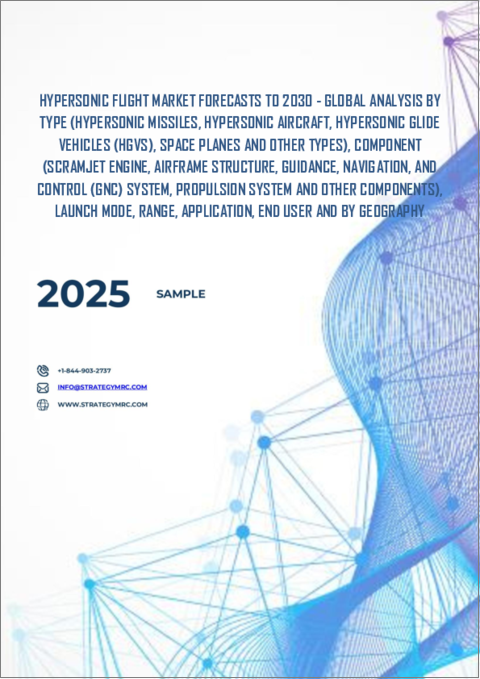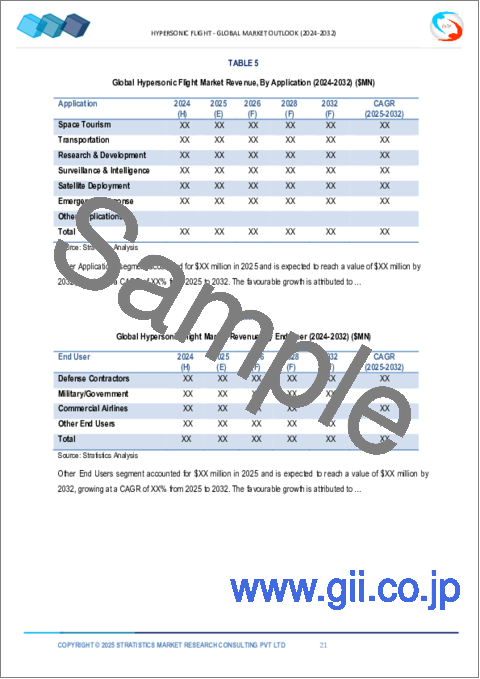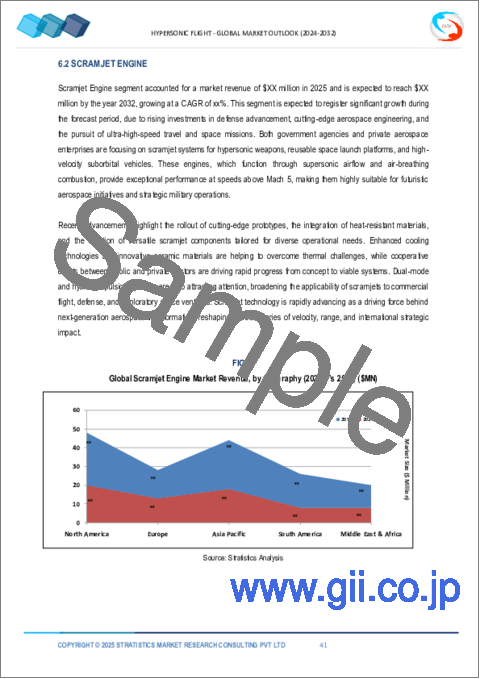|
|
市場調査レポート
商品コード
1489378
極超音速飛行市場の2030年までの予測: タイプ、コンポーネント、発射モード、航続距離、用途、エンドユーザー、地域別の世界分析Hypersonic Flight Market Forecasts to 2030 - Global Analysis By Type, Component, Launch Mode, Range, Application, End User and By Geography |
||||||
カスタマイズ可能
|
|||||||
| 極超音速飛行市場の2030年までの予測: タイプ、コンポーネント、発射モード、航続距離、用途、エンドユーザー、地域別の世界分析 |
|
出版日: 2024年06月06日
発行: Stratistics Market Research Consulting
ページ情報: 英文 200+ Pages
納期: 2~3営業日
|
全表示
- 概要
- 図表
- 目次
Stratistics MRCによると、世界の極超音速飛行市場は2023年に69億4,000万米ドルを占め、2030年には153億8,000万米ドルに達すると予測され、予測期間中のCAGRは12.4%です。
極超音速飛行は航空宇宙技術における次のフロンティアであり、マッハ5、すなわち音速の5倍を超える速度が特徴です。この高速移動の領域は、軍事、商業、科学の各領域に変革をもたらす可能性を秘めています。最先端の推進システムと先端素材を活用した極超音速機は、移動時間の大幅な短縮、偵察能力の強化、より機敏な軍事作戦を約束します。極超音速飛行システムの開発は、世界各地への迅速な移動からミサイル防衛の強化に至るまで、航空宇宙工学における比類なきスピードと敏捷性の新時代を告げるものです。
そのため、米国はDoD(国防総省)が2023年から2027年にかけて極超音速ミサイルの開発を要請し、極超音速兵器に130億米ドルの巨額投資を行った。
世界な安全保障への懸念
地政学的緊張の高まりと安全保障上の脅威の進展により、各国は軍事用途の極超音速技術の開発を優先しています。これには、迅速な攻撃能力やミサイル防衛システムの強化が含まれます。戦略的優位性を維持し、潜在的な敵対勢力を抑止する必要性から、極超音速研究開発への投資が活発化しています。その結果、極超音速兵器や監視システムへの需要が高まり、この分野の技術革新と拡大が促進されます。
技術的課題
極超音速飛行における技術的課題には、極端な空力加熱の管理、構造的完全性の維持、熱管理問題への対処などがあります。これらのハードルは、開発スケジュールを長期化させ、コストを増大させ、安全上のリスクをもたらします。これらの課題は複雑であるため、広範な調査と試験が必要となり、資源集約的な取り組みとなります。さらに、未解決の技術的問題は、潜在的な投資家や利害関係者が極超音速プロジェクトにコミットすることを躊躇させ、市場の成長を妨げる可能性があります。
材料科学の継続的進歩
材料科学の進歩により、極超音速飛行中に経験する極端な温度と空気力学的応力に耐えることができる軽量かつ堅牢な材料の開発が可能になった。これらの材料は、高性能の極超音速機、推進システム、熱保護システムの構築を容易にし、軽量化、効率改善、全体的な性能向上を実現します。材料科学が進化を続けるにつれ、極超音速技術の革新ペースが加速し、軍事・商業用途の両方において実現可能性とコスト効率が向上しています。
コスト制約
極超音速飛行におけるコスト上の制約は、極超音速機とインフラの研究、開発、配備に関連する多額の費用に起因します。高コストは、特殊な材料、高度な推進システム、厳格な試験、極端な速度と温度に耐える複雑な製造工程が必要なことに起因します。これらの費用は、特に収益性を求める商業ベンチャーにとって、参入への大きな障壁となります。
COVID-19の影響
COVID-19の流行は極超音速飛行市場にさまざまな影響を与えました。サプライ・チェーン、労働力の確保、資金調達における初期の混乱は、プロジェクトのスケジュールと投資に影響を与えたが、この危機はまた、世界の連結性と安全保障のための迅速で効率的な輸送の重要性を強調しました。各国が景気後退からの回復に努める中、防衛の近代化や商業的応用のための極超音速技術への関心と投資が再燃しています。しかし、旅行需要に関する長引く不確実性と予算の制約が、市場力学に影響を与え続けています。
極超音速航空機分野は予測期間中最大になる見込み
極超音速航空機セグメントは有利な成長を遂げると推定されます。極超音速航空機は、マッハ5、つまり音速の5倍を超える速度で移動するように設計された乗り物です。極超音速機は、膨大な距離を最短時間で移動できるため、世界の輸送や軍事能力に革命をもたらす大きな可能性を秘めています。これらの航空機は、極超音速を達成するために、スクラムジェットやラムジェットなどの高度な推進システムを利用します。極超音速航空機は、将来、迅速で効率的な移動を可能にし、防衛能力を強化することが期待されています。
予測期間中、CAGRが最も高くなると予想されるのは衛星配備分野です。
衛星配備分野は、打ち上げコストの大幅な削減と柔軟性の向上が期待できることから、予測期間中に最も高いCAGRの成長が見込まれます。極超音速機は、迅速かつ再利用可能でコスト効率の高い宇宙へのアクセスを提供し、より頻繁で迅速な衛星展開を可能にします。空気呼吸推進システムを活用することで、従来のロケット打ち上げよりも高い速度と高度を達成し、軌道到達に必要なエネルギーを削減することができます。
最大のシェアを占める地域:
アジア太平洋地域は、軍事的近代化、技術的進歩、商業的機会に牽引され、予測期間中最大の市場シェアを占めると予測されます。中国、インド、日本などの国々は、軍事力を強化し戦略的優位性を維持するために極超音速の研究開発に多額の投資を行っています。さらに、極超音速旅客機や貨物輸送ソリューションを模索する企業もあり、商業的関心も高まっています。政府、研究機関、航空宇宙企業間の協力関係が、この地域での進展を加速させています。
CAGRが最も高い地域:
北米は、特に米国における防衛・航空宇宙分野への多額の投資により、予測期間中に最も高いCAGRを示すと予測されます。同地域は、高度な技術力、強固なインフラ、強力な研究機関により、極超音速研究開発のリーダーとしての地位を確立しています。米国の極超音速通常攻撃兵器プログラムのような政府のイニシアチブは市場の成長を促進し、防衛請負業者、政府機関、学界のコラボレーションは技術革新を促進します。
無料のカスタマイズサービス
本レポートをご購読のお客様には、以下の無料カスタマイズオプションのいずれかをご利用いただけます:
- 企業プロファイル
- 追加市場プレイヤーの包括的プロファイリング(3社まで)
- 主要企業のSWOT分析(3社まで)
- 地域セグメンテーション
- 顧客の関心に応じた主要国の市場推計・予測・CAGR(注:フィージビリティチェックによる)
- 競合ベンチマーキング
- 製品ポートフォリオ、地理的プレゼンス、戦略的提携に基づく主要企業のベンチマーキング
目次
第1章 エグゼクティブサマリー
第2章 序文
- 概要
- ステークホルダー
- 調査範囲
- 調査手法
- データマイニング
- データ分析
- データ検証
- 調査アプローチ
- 調査情報源
- 1次調査情報源
- 2次調査情報源
- 前提条件
第3章 市場動向分析
- 促進要因
- 抑制要因
- 機会
- 脅威
- 用途分析
- エンドユーザー分析
- 新興市場
- COVID-19の影響
第4章 ポーターのファイブフォース分析
- 供給企業の交渉力
- 買い手の交渉力
- 代替品の脅威
- 新規参入業者の脅威
- 競争企業間の敵対関係
第5章 世界の極超音速飛行市場:タイプ別
- 極超音速ミサイル
- 極超音速航空機
- 極超音速滑空体(HGV)
- スペースプレーン
- その他のタイプ
第6章 世界の極超音速飛行市場:コンポーネント別
- スクラムジェットエンジン
- 機体構造
- 誘導、航行、制御(GNC)システム
- 推進システム
- その他のコンポーネント
第7章 世界の極超音速飛行市場:発射モード別
- 空中発射
- 地上発射
- 海上発射
- 宇宙発射
第8章 世界の極超音速飛行市場:範囲別
- 短距離
- 中距離
- 長距離
- 超長距離
第9章 世界の極超音速飛行市場:用途別
- 宇宙旅行
- 輸送機関
- 研究開発
- 監視と情報
- 衛星の展開
- 緊急対応
- その他の用途
第10章 世界の極超音速飛行市場:エンドユーザー別
- 防衛関連企業
- 軍事/政府
- 民間航空会社
- その他のエンドユーザー
第11章 世界の極超音速飛行市場:地域別
- 北米
- 米国
- カナダ
- メキシコ
- 欧州
- ドイツ
- 英国
- イタリア
- フランス
- スペイン
- その他欧州
- アジア太平洋地域
- 日本
- 中国
- インド
- オーストラリア
- ニュージーランド
- 韓国
- その他アジア太平洋地域
- 南米
- アルゼンチン
- ブラジル
- チリ
- その他南米
- 中東・アフリカ
- サウジアラビア
- アラブ首長国連邦
- カタール
- 南アフリカ
- その他中東とアフリカ
第12章 主な発展
- 契約、パートナーシップ、コラボレーション、合弁事業
- 買収と合併
- 新製品発売
- 事業拡大
- その他の主要戦略
第13章 企業プロファイリング
- Lockheed Martin Corporation
- Boeing Company
- Northrop Grumman Corporation
- Raytheon Technologies Corporation
- BAE Systems PLC
- Aerojet Rocketdyne Holdings Inc.
- General Dynamics Corporation
- SpaceX
- Virgin Galactic Holdings Inc.
- Blue Origin LLC
- Thales Group
- Saab AB
- Mitsubishi Heavy Industries
- Rolls-Royce Holdings PLC
- Reaction Engines Limited
List of Tables
- Table 1 Global Hypersonic Flight Market Outlook, By Region (2021-2030) ($MN)
- Table 2 Global Hypersonic Flight Market Outlook, By Type (2021-2030) ($MN)
- Table 3 Global Hypersonic Flight Market Outlook, By Hypersonic Missiles (2021-2030) ($MN)
- Table 4 Global Hypersonic Flight Market Outlook, By Hypersonic Aircraft (2021-2030) ($MN)
- Table 5 Global Hypersonic Flight Market Outlook, By Hypersonic Glide Vehicles (HGVs) (2021-2030) ($MN)
- Table 6 Global Hypersonic Flight Market Outlook, By Space Planes (2021-2030) ($MN)
- Table 7 Global Hypersonic Flight Market Outlook, By Other Types (2021-2030) ($MN)
- Table 8 Global Hypersonic Flight Market Outlook, By Component (2021-2030) ($MN)
- Table 9 Global Hypersonic Flight Market Outlook, By Scramjet Engine (2021-2030) ($MN)
- Table 10 Global Hypersonic Flight Market Outlook, By Airframe Structure (2021-2030) ($MN)
- Table 11 Global Hypersonic Flight Market Outlook, By Guidance, Navigation, and Control (GNC) System (2021-2030) ($MN)
- Table 12 Global Hypersonic Flight Market Outlook, By Propulsion System (2021-2030) ($MN)
- Table 13 Global Hypersonic Flight Market Outlook, By Other Components (2021-2030) ($MN)
- Table 14 Global Hypersonic Flight Market Outlook, By Launch Mode (2021-2030) ($MN)
- Table 15 Global Hypersonic Flight Market Outlook, By Air-Launched (2021-2030) ($MN)
- Table 16 Global Hypersonic Flight Market Outlook, By Ground-Launched (2021-2030) ($MN)
- Table 17 Global Hypersonic Flight Market Outlook, By Sea-Launched (2021-2030) ($MN)
- Table 18 Global Hypersonic Flight Market Outlook, By Space-Launched (2021-2030) ($MN)
- Table 19 Global Hypersonic Flight Market Outlook, By Range (2021-2030) ($MN)
- Table 20 Global Hypersonic Flight Market Outlook, By Short-Range (2021-2030) ($MN)
- Table 21 Global Hypersonic Flight Market Outlook, By Medium-Range (2021-2030) ($MN)
- Table 22 Global Hypersonic Flight Market Outlook, By Long-Range (2021-2030) ($MN)
- Table 23 Global Hypersonic Flight Market Outlook, By Ultra-Long Range (2021-2030) ($MN)
- Table 24 Global Hypersonic Flight Market Outlook, By Application (2021-2030) ($MN)
- Table 25 Global Hypersonic Flight Market Outlook, By Space Tourism (2021-2030) ($MN)
- Table 26 Global Hypersonic Flight Market Outlook, By Transportation (2021-2030) ($MN)
- Table 27 Global Hypersonic Flight Market Outlook, By Research & Development (2021-2030) ($MN)
- Table 28 Global Hypersonic Flight Market Outlook, By Surveillance & Intelligence (2021-2030) ($MN)
- Table 29 Global Hypersonic Flight Market Outlook, By Satellite Deployment (2021-2030) ($MN)
- Table 30 Global Hypersonic Flight Market Outlook, By Emergency Response (2021-2030) ($MN)
- Table 31 Global Hypersonic Flight Market Outlook, By Other Applications (2021-2030) ($MN)
- Table 32 Global Hypersonic Flight Market Outlook, By End User (2021-2030) ($MN)
- Table 33 Global Hypersonic Flight Market Outlook, By Defense Contractors (2021-2030) ($MN)
- Table 34 Global Hypersonic Flight Market Outlook, By Military/Government (2021-2030) ($MN)
- Table 35 Global Hypersonic Flight Market Outlook, By Commercial Airlines (2021-2030) ($MN)
- Table 36 Global Hypersonic Flight Market Outlook, By Other End Users (2021-2030) ($MN)
Note: Tables for North America, Europe, APAC, South America, and Middle East & Africa Regions are also represented in the same manner as above.
According to Stratistics MRC, the Global Hypersonic Flight Market is accounted for $6.94 billion in 2023 and is expected to reach $15.38 billion by 2030 growing at a CAGR of 12.4% during the forecast period. Hypersonic flight represents the next frontier in aerospace technology, characterized by speeds exceeding Mach 5, or five times the speed of sound. This realm of high-speed travel offers transformative potential across military, commercial, and scientific domains. Utilizing cutting-edge propulsion systems and advanced materials, hypersonic vehicles promise vastly reduced travel times, enhanced reconnaissance capabilities, and more agile military operations. With potential applications ranging from rapid global travel to enhanced missile defense, the development of hypersonic flight systems heralds a new era of unparalleled speed and agility in aerospace engineering.
Accordingly, the US made a significant investment of USD 13 billion in hypersonic weapons with a request by the DoD (Department of Defense) to develop hypersonic missiles from 2023 to 2027.
Market Dynamics:
Driver:
Global security concerns
Heightened geopolitical tensions and evolving security threats prompt nations to prioritize the development of hypersonic technologies for military applications. These include rapid strike capabilities and enhanced missile defense systems. The need to maintain strategic superiority and deter potential adversaries fuels investments in hypersonic research and development. Consequently, the market experiences increased demand for hypersonic weapons and surveillance systems, driving innovation and expansion in the sector.
Restraint:
Technical challenges
Technical challenges in hypersonic flight include managing extreme aerodynamic heating, maintaining structural integrity, and addressing thermal management issues. These hurdles prolong development timelines, increase costs, and pose safety risks. The complexity of these challenges necessitates extensive research and testing, leading to resource-intensive efforts. Moreover, unresolved technical issues may deter potential investors and stakeholders from committing to hypersonic projects, hampering market growth.
Opportunity:
Ongoing advancements in materials science
Ongoing advancements in materials science enables the development of lightweight yet robust materials capable of withstanding extreme temperatures and aerodynamic stresses experienced during hypersonic flight. These materials facilitate the construction of high-performance hypersonic vehicles, propulsion systems, and thermal protection systems, reducing weight, improving efficiency, and enhancing overall performance. As materials science continues to evolve, it accelerates the pace of innovation in hypersonic technology, making it more feasible and cost-effective for both military and commercial applications.
Threat:
Cost constraints
Cost constraints in hypersonic flight arise due to the substantial expenses associated with research, development, and deployment of hypersonic vehicles and infrastructure. High costs stem from the need for specialized materials, advanced propulsion systems, rigorous testing, and complex manufacturing processes to withstand extreme speeds and temperatures. These expenses pose significant barriers to entry, particularly for commercial ventures seeking profitability.
Covid-19 Impact
The covid-19 pandemic has had a mixed impact on the hypersonic flight market. While initial disruptions in supply chains, workforce availability, and funding affected project timelines and investments, the crisis also underscored the importance of rapid, efficient transportation for global connectivity and security. As nations strive to recover from the economic downturn, there's renewed interest and investment in hypersonic technologies for defense modernization and commercial applications. However, lingering uncertainties regarding travel demand and budgetary constraints continue to influence market dynamics.
The hypersonic aircraft segment is expected to be the largest during the forecast period
The hypersonic aircraft segment is estimated to have a lucrative growth. Hypersonic aircraft are vehicles designed to travel at speeds exceeding Mach 5, or five times the speed of sound. They offer immense potential for revolutionizing global transportation and military capabilities due to their ability to cover vast distances in minimal time. These aircraft utilize advanced propulsion systems, such as scramjets or ramjets, to achieve hypersonic speeds. Hypersonic aircraft hold promise for enabling rapid, efficient travel and enhancing defense capabilities in the future.
The satellite deployment segment is expected to have the highest CAGR during the forecast period
The satellite deployment segment is anticipated to witness the highest CAGR growth during the forecast period, due to its potential to significantly reduce launch costs and increase flexibility. Hypersonic vehicles could offer rapid, reusable, and cost-effective access to space, enabling more frequent and responsive satellite deployments. By leveraging air-breathing propulsion systems, these vehicles could achieve higher velocities and altitudes than traditional rocket-based launches, reducing the energy required to reach orbit.
Region with largest share:
Asia Pacific is projected to hold the largest market share during the forecast period driven by military modernization, technological advancements, and commercial opportunities. Countries like China, India, and Japan are investing heavily in hypersonic research and development to bolster their military capabilities and maintain strategic superiority. Additionally, commercial interest is growing, with companies exploring hypersonic passenger travel and cargo delivery solutions. Collaborations between governments, research institutions, and aerospace companies are accelerating progress in the region.
Region with highest CAGR:
North America is projected to have the highest CAGR over the forecast period, owing to substantial investments in defense and aerospace sectors, particularly in the United States. The region's advanced technological capabilities, robust infrastructure, and strong research institutions position it as a leader in hypersonic research and development. Government initiatives like the United States' Hypersonic Conventional Strike Weapon program drive market growth, while collaborations between defense contractors, government agencies, and academia foster innovation.
Key players in the market
Some of the key players profiled in the Hypersonic Flight Market include Lockheed Martin Corporation, Boeing Company, Northrop Grumman Corporation, Raytheon Technologies Corporation, BAE Systems PLC, Aerojet Rocketdyne Holdings Inc., General Dynamics Corporation, SpaceX, Virgin Galactic Holdings Inc., Blue Origin LLC, Thales Group, Saab AB, Mitsubishi Heavy Industries, Rolls-Royce Holdings PLC and Reaction Engines Limited.
Key Developments:
In April 2023, Mitsubishi Heavy Industries was awarded numerous contracts from the Ministry of Defense (Japan) for development of missile systems including hypersonic weapons. The contract was valued at USD 883 million and was aimed to develop hypersonic cruise missile and hypersonic glide vehicles.
In March 2023, Raytheon Technologies Corporation was awarded a contract by the US Air Force to build hypersonic cruise missile under the HACM Programme (Hypersonic attack cruise missile). The contract was worth USD 985 million.
Types Covered:
- Hypersonic Missiles
- Hypersonic Aircraft
- Hypersonic Glide Vehicles (HGVs)
- Space Planes
- Other Types
Components Covered:
- Scramjet Engine
- Airframe Structure
- Guidance, Navigation, and Control (GNC) System
- Propulsion System
- Other Components
Launch Modes Covered:
- Air-Launched
- Ground-Launched
- Sea-Launched
- Space-Launched
Ranges Covered:
- Short-Range
- Medium-Range
- Long-Range
- Ultra-Long Range
Applications Covered:
- Space Tourism
- Transportation
- Research & Development
- Surveillance & Intelligence
- Satellite Deployment
- Emergency Response
- Other Applications
End Users Covered:
- Defense Contractors
- Military/Government
- Commercial Airlines
- Other End Users
Regions Covered:
- North America
- US
- Canada
- Mexico
- Europe
- Germany
- UK
- Italy
- France
- Spain
- Rest of Europe
- Asia Pacific
- Japan
- China
- India
- Australia
- New Zealand
- South Korea
- Rest of Asia Pacific
- South America
- Argentina
- Brazil
- Chile
- Rest of South America
- Middle East & Africa
- Saudi Arabia
- UAE
- Qatar
- South Africa
- Rest of Middle East & Africa
What our report offers:
- Market share assessments for the regional and country-level segments
- Strategic recommendations for the new entrants
- Covers Market data for the years 2021, 2022, 2023, 2026, and 2030
- Market Trends (Drivers, Constraints, Opportunities, Threats, Challenges, Investment Opportunities, and recommendations)
- Strategic recommendations in key business segments based on the market estimations
- Competitive landscaping mapping the key common trends
- Company profiling with detailed strategies, financials, and recent developments
- Supply chain trends mapping the latest technological advancements
Free Customization Offerings:
All the customers of this report will be entitled to receive one of the following free customization options:
- Company Profiling
- Comprehensive profiling of additional market players (up to 3)
- SWOT Analysis of key players (up to 3)
- Regional Segmentation
- Market estimations, Forecasts and CAGR of any prominent country as per the client's interest (Note: Depends on feasibility check)
- Competitive Benchmarking
- Benchmarking of key players based on product portfolio, geographical presence, and strategic alliances
Table of Contents
1 Executive Summary
2 Preface
- 2.1 Abstract
- 2.2 Stake Holders
- 2.3 Research Scope
- 2.4 Research Methodology
- 2.4.1 Data Mining
- 2.4.2 Data Analysis
- 2.4.3 Data Validation
- 2.4.4 Research Approach
- 2.5 Research Sources
- 2.5.1 Primary Research Sources
- 2.5.2 Secondary Research Sources
- 2.5.3 Assumptions
3 Market Trend Analysis
- 3.1 Introduction
- 3.2 Drivers
- 3.3 Restraints
- 3.4 Opportunities
- 3.5 Threats
- 3.6 Application Analysis
- 3.7 End User Analysis
- 3.8 Emerging Markets
- 3.9 Impact of Covid-19
4 Porters Five Force Analysis
- 4.1 Bargaining power of suppliers
- 4.2 Bargaining power of buyers
- 4.3 Threat of substitutes
- 4.4 Threat of new entrants
- 4.5 Competitive rivalry
5 Global Hypersonic Flight Market, By Type
- 5.1 Introduction
- 5.2 Hypersonic Missiles
- 5.3 Hypersonic Aircraft
- 5.4 Hypersonic Glide Vehicles (HGVs)
- 5.5 Space Planes
- 5.6 Other Types
6 Global Hypersonic Flight Market, By Component
- 6.1 Introduction
- 6.2 Scramjet Engine
- 6.3 Airframe Structure
- 6.4 Guidance, Navigation, and Control (GNC) System
- 6.5 Propulsion System
- 6.6 Other Components
7 Global Hypersonic Flight Market, By Launch Mode
- 7.1 Introduction
- 7.2 Air-Launched
- 7.3 Ground-Launched
- 7.4 Sea-Launched
- 7.5 Space-Launched
8 Global Hypersonic Flight Market, By Range
- 8.1 Introduction
- 8.2 Short-Range
- 8.3 Medium-Range
- 8.4 Long-Range
- 8.5 Ultra-Long Range
9 Global Hypersonic Flight Market, By Application
- 9.1 Introduction
- 9.2 Space Tourism
- 9.3 Transportation
- 9.4 Research & Development
- 9.5 Surveillance & Intelligence
- 9.6 Satellite Deployment
- 9.7 Emergency Response
- 9.8 Other Applications
10 Global Hypersonic Flight Market, By End User
- 10.1 Introduction
- 10.2 Defense Contractors
- 10.3 Military/Government
- 10.4 Commercial Airlines
- 10.5 Other End Users
11 Global Hypersonic Flight Market, By Geography
- 11.1 Introduction
- 11.2 North America
- 11.2.1 US
- 11.2.2 Canada
- 11.2.3 Mexico
- 11.3 Europe
- 11.3.1 Germany
- 11.3.2 UK
- 11.3.3 Italy
- 11.3.4 France
- 11.3.5 Spain
- 11.3.6 Rest of Europe
- 11.4 Asia Pacific
- 11.4.1 Japan
- 11.4.2 China
- 11.4.3 India
- 11.4.4 Australia
- 11.4.5 New Zealand
- 11.4.6 South Korea
- 11.4.7 Rest of Asia Pacific
- 11.5 South America
- 11.5.1 Argentina
- 11.5.2 Brazil
- 11.5.3 Chile
- 11.5.4 Rest of South America
- 11.6 Middle East & Africa
- 11.6.1 Saudi Arabia
- 11.6.2 UAE
- 11.6.3 Qatar
- 11.6.4 South Africa
- 11.6.5 Rest of Middle East & Africa
12 Key Developments
- 12.1 Agreements, Partnerships, Collaborations and Joint Ventures
- 12.2 Acquisitions & Mergers
- 12.3 New Product Launch
- 12.4 Expansions
- 12.5 Other Key Strategies
13 Company Profiling
- 13.1 Lockheed Martin Corporation
- 13.2 Boeing Company
- 13.3 Northrop Grumman Corporation
- 13.4 Raytheon Technologies Corporation
- 13.5 BAE Systems PLC
- 13.6 Aerojet Rocketdyne Holdings Inc.
- 13.7 General Dynamics Corporation
- 13.8 SpaceX
- 13.9 Virgin Galactic Holdings Inc.
- 13.10 Blue Origin LLC
- 13.11 Thales Group
- 13.12 Saab AB
- 13.13 Mitsubishi Heavy Industries
- 13.14 Rolls-Royce Holdings PLC
- 13.15 Reaction Engines Limited






